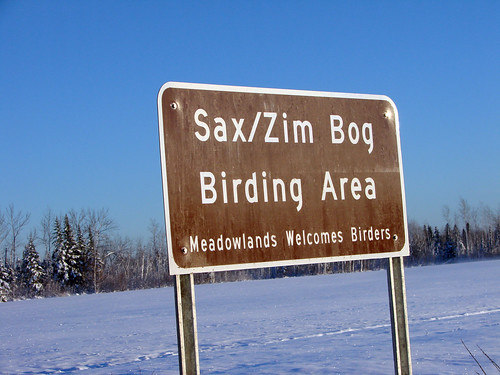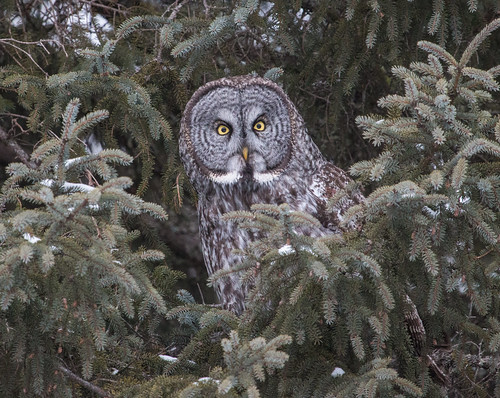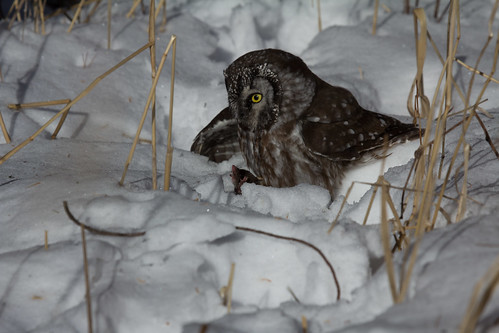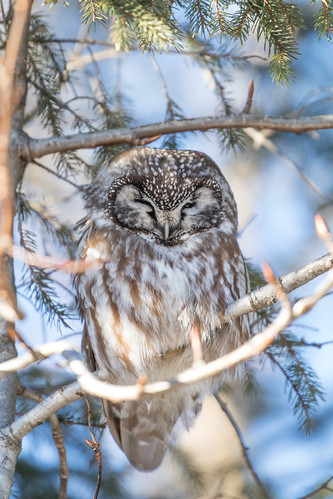This weekend is a big one for me—it’s the Sax-Zim Birding Festival centered in Meadowlands, and I get to be the keynote speaker: I'll be talking about how birds survive winter.
This also means I get to spend the weekend with my good friends Chuck and Gail Prudhomme, who live on the Little Whiteface River. When I was doing regular Big Days, my team used to stay in a lovely cabin on Chuck and Gail’s property. We always started with me getting up, at 2:30 am. I’d head to the outhouse first to try to call in a Barred Owl. Most people are too impatient with owls. I’d call two or three times, then head back in the cabin to get dressed. By the time our team of four was ready to set out, at least one and often a pair of Barred Owls had silently flown in. At that point, we'd call back and forth a bit. Only once did I get a response from the direction of Chuck and Gail’s house, in a voice that sounded suspiciously like Chuck’s. But even that year, the real owls flew in before we left. And even in the dark at 2:45 am we usually heard at least a couple more species before we headed out.
I also rented Chuck and Gail’s cabin once when my daughter was home from college—she and I had a wonderful mother-daughter bonding experience there, just the two of us on a beautiful August evening. I’ve only spent a bit of time at Chuck and Gail's in winter, but I’m looking forward to making sound recordings at their bird feeders this time. And the best thing, of course, will be getting to spend time with them again.
Registration for the festival has been filled for quite a while—Meadowlands is tiny, and so they set maximum registration at 150. The big draw, of course, is winter owls, and this year promises to be good. I always have mixed feelings about that—the Great Grays and Northern Hawk Owls come for the meadow voles in the open boggy habitat; the boreals for our lovely woods where they try to sit with their eyes mostly closed in hopes of being unobserved, or when they’re in desperate straits where they try to hunt without distractions.
But the moment people spot them, all bets are off. For some reason, our species—the one species on the planet that includes rocket scientists and Red Cross nurses—isn’t very smart or kind about wildlife, perhaps especially owls. I’ve talked to several people this winter who saw people walk straight toward owls, which invariably got the owl distressed enough to fly off. I’ve heard even supposedly knowledgeable birders claim that this isn’t harmful—birds fly when they’re stalked by natural predators, too—but there are a heck of a lot more of us than natural predators. Every time we disturb an owl, we make it easier for it to be spotted and harassed by crows or jays, or even chickadees. Chickadees can’t hurt even a tiny saw-whet or boreal owl, but their tiny obscenities do alert larger birds that can harm the owl. Many bird guides do their darnedest to keep their groups at a respectful distance—that’s what spotting scopes are for. Sometimes, of course, even the most respectful birders get very close to an owl, but that depends on the owl flying in, not the birder walking ever closer and closer.
My very best photos of a Boreal Owl ever were taken in Two Harbors. Russ and I had been looking for one, and then Jim Lind spotted us and came down to visit. We were chatting away for several minutes before we looked up and there it was! We watched it as it even caught a shrew. And the sun was behind us, so all my photos show it in perfect or at least pretty good light.
Of course, most of my Boreal Owl photos are of birds with their eyes mostly closed—the way they try to keep their eyes while roosting, because those round yellow eyes are a clear signal of danger to other birds, which will try to drive away the little guy. I see way too many photos of owls looking alarmed, clearly by the photographer.
For me, the first rule of birding is “Above all, do no harm.” With luck, respect and generosity to the birds will prevail at this weekend’s festival.
This late-winter count gets numbers quite different from the early-winter Christmas Bird Count, and uses an entirely different protocol—for the GBBC, you count every bird you see, keeping track of where you saw it. You don’t need to be part of any official group, staying within a specific count circle. The data helps us keep track of bird movements in different winters, which is important for tracking population trends.
All you have to do is go to eBird.org or birdcount.org to participate. If you’re reading this after the weekend is over, you can still submit the birds you saw this weekend at eBird.org. When you register, which is free, you can opt out of receiving emails from Cornell or Audubon. I support both organizations because they provide so much valuable information for the general public as well as for scientists and conservationists, but you don’t have to give them money or read their emails to get to use their valuable services.
The cool thing about eBird is that it will keep track of your birds for you, so once you’ve submitted data, you can then use it to effortlessly keep track of your lifelist, year list, backyard list, and county lists. And on top of that, the data helps scientists protect those very birds. If you’re not using eBird, this weekend is a great time to start. If you’re going out to see birds, great! If you’re stuck indoors, you can report just what you see looking out the window. It’s fun, it’s valuable for both scientists and the birds they study, and it’s the right thing to do.





